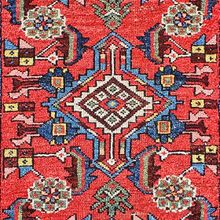Zagheh Rug
| Zagheh Rug | |
|---|---|
 Design of Zagheh Rug (Rugman) | |
| General information | |
| Name | Zagheh Rug |
| Original name | قالی زاغه |
| Alternative name(s) | Zagheh Carpet |
| Origin | |
| Category | Village |
| Technical information | |
| Common designs | Medallion (Toranj), Herati (Fish) |
| Common colors | Red, Blue, Navy Blue, Beige, Green |
| Dyeing method | Natural, Synthetic |
| Pile material | Wool |
| Foundation material | Cotton |
| Knot type | Symmetrical (Turkish) |
Zagheh rugs are hand-woven Persian tribal carpets made in the Kurdish nomadic districts of Northeastern Iran. Zagheh is the name given to a group of nomadic people living in the surrounding area of Hamadan. The bright colors and geometric shapes are typical of tribal weaving from this area of Iran. A rug such as this takes a nomadic woman, sometimes working with her daughter, several months of concentrated weaving to complete on a crude loom on the ground outside the family tent. Most rugs woven by tribal people are intended for their own use as floor coverings or sleeping mats.
History
Zagheh is a village in the Hamadan Province of western Iran. The village has mostly a Kurdish population. Zagheh rugs are known in the market from the first quarter of the twentieth century. The weavings are categorized as part of the Hamadan Mosul Rugs group.[1]
Materials
Foundation and Pile
The rugs have a cotton foundation and a wool pile.[2]
Techniques and structures
Color and dyeing
The rug field colors are mostly dark blue, with a small percentage of reds or ivory. The borders generally feature an ivory ground.[3]
Motifs and Designs
Zagheh rugs have semigeometric designs in a medallion or allover style. The fields feature the traditional Boteh (paisley) or Herati (fish) patterns. In the center is a small pendant-shaped medallion, which is also quartered and placed in each corner of the field. The main border design generally contains large stylized flower heads surrounded by leaves, flowers, and vines. Zagheh weavers use border designs from the neighboring Hamadan villages.[4]
Weaving techniques
These rugs are single-wefted with the (symmetrical) knot on a cotton foundation.[5] The weave quality is medium to good in grade. Zagheh rug formats range from small mats to rugs approximately seven feet by four feet six inches. Runners are made up to seventeen feet in length. In rare instances, room sizes can be found in the market.[6]
See also
| Search for Zagheh Rug on Wikipedia. |
References
Bibliography
- Abraham Levi Moheban, (2015), The Encyclopedia of Antique Carpets: Twenty-Five Centuries of Weaving, NewYork: Princeton Architectural Press.
- Peter F. Stone, (2013), Oriental Rugs: An Illustrated Lexicon of Motifs, Materials, and Origins Kindle Edition, North Clarendon :Tuttle.
